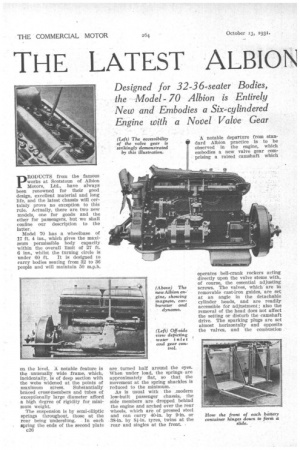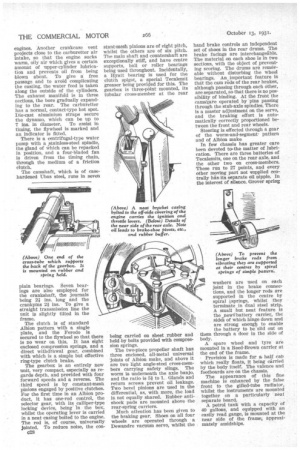THE LATEST ALBION BUS CHASSIS
Page 48

Page 49

Page 50

If you've noticed an error in this article please click here to report it so we can fix it.
Designed for 32-36-seater Bodies, the Model 70 Albion is Entirely New and Embodies a Six-cylindered Engine with a Novel Valve Gear
pRODUCTS from the famous works at Scotstoun of Albion Motors, Ltd., have always been renowned for their good design, excellent material and long life, and the latest chassis will certainly prove no ex-ception to this rule. Actually, there are two new models, one for goods and the other for passengers, but we shall confine our description to the latter.
Model 70 has a wheelbase of 17 ft. 4 ins., which gives the maximum permissible body capacity within the overall limit of 27 ft. 6 ins., whilst the turning circle is under 60 ft. It is designed to carry bodies seating from 32 to 36 people and will maintain 50 m.p.h.
on the level. A notable feature is the unusually wide frame, which, incidentally, is of deep section with the webs widened at the points of maximum stress. Substantially braced cross-members and tubes of exceptionally large diameter afford a high degree of rigidity for minimum weight.
The suspension is by semi-elliptic springs throughout, those at the rear being undershing. In each spring the ends of the second plate e26 are turned half around the eyes. When under load, the springs are approximately flat, so that the movement at the spring shackles is reduced to the minimum.
As is usual with the .modern low-built passenger chassis, the side members are dropped behind the engine and arched over the rear wheels, which are of pressed steel and can carry 40-in. by 9-in. or 38-in. by 8k-in. tyres, twins at the rear and singles at the front. •
A notable departure from standard Albion practice is to be observed in the engine, which tembodies a new valve gear comprising a raised camshaft which
operates bell-crank rockers acting directly upon the valve stems with, of course, the essential adjusting screws. The valves, which are in removable cast-iron guides, are set at an angle in the detachable cylinder heads, and are readily accessible for adjustment; also the removal of the head does not affect the setting or disturb the camshaft drive. The sparking plugs are set almost horizontally and opposite the valves, and the combustion
spaces are approximately triangular in the vertical section. Two readily removable aluminium covers enclose the valve gear. This arrangement of the valve gear was the subject of a patent taken out by the late Dr. Murray some years ago, but this is the first time it has been adopted on Albion engines.
The six cylinders are of 314n. bore and 4i-in. stroke, giving an R.A.C. rating of 36 h.p., and developing 85 b.h.p. at 'normal r.p.m. The six cylinders are cast in one with the upper half of the crankcase and the barrels contain renewable dry liners which are pressed into position. It is notable. that the exhaust-valve seats are also inserted under pressure, thus these important components can be made of a much finer.
quality of iron, The unit is, of course, of the modern, high-compression type. Light-metal pistons are employed, each having two gas rings and two scraper rings, one above the gudgeon pin, and one below. The heads are concave.
Ignition is effected by a Simms magneto strap-fixed above the dynamo and driven separately through a vernier coupling. An endless Duplex chain drives the timing, gear, and an eccentric-type automatic tensioner is utilized. There is also a 2-to-1 reduction by ground straight-spur gears.
The sump oil capacity is over three gallons, and the oil is sucked up to the pump through a• strainer of exceptionally large area, so that any dirt falls to the bottom. The oil pump is of the gear pattern and is carried in its own little sump at the forward end, being driven by mitre gears. These are lubricated from the oil-relief valve, an aluminium reflector directing the oil over the gears. Oil passages are provided in the crankcase and drilled In the crankshaft, except for the hollow crankpins, through which the lubricant is conveyed by pipes.
There is a large filler orifice above the timing ease and it is notable that breathers are mounted high above this case and above the valve covers. These prevent water condensation en the timing chain and valve gear, a trouble which actually causes, rust in some engines. Another crankcase vent projects close to the carburetter air intake, so that the engine sucks warm, oily air which gives a certain amount of upper-cylinder lubrication and prevents oil from being blown about. To give a free passage and to avoid complicating the casting, the water feed is taken along the outside of the cylinders. The exhaust manifold is in three sections, the bore gradually expanding to the rear. The carburetter has a normal, contact-type hot spot. Die-cast aluminium straps secure the dynamo, which can be up to 7 ins, in diameter. To assist in timing, the flywheel is marked and an indicator is fitted.
There is a centrifugal-type water pump with a _stainless-steel spindle, the gland of which can be repacked in position, and a four-bladed fan is driven from the timing chain, through the medium of a friction clutch.
The camshaft, which is of casehardened IThas steel, runs in seven plain bearings. Seven bearings are also employed for the crankshaft, the journals being 21 ins, long and the crankpins 21 ins. To give a straight transmission line the unit is slightly tilted in the frame.
The clutch is of standard Albion pattern with a single plate, and the Ferodo is secured to the flywheel so that there is no wear on this. It has eight enclosed compression springs, and a direct withdiawal gear, combined with which is a simple but effective ring-type clutch brake.
The gearbox is an entirely new unit, very compact, especially as regards depth, and provided with four forward speeds and a reverse. The .third speed is by constant-mesh pinions engaged by positive clutches. For the first time in an Albion product, it has one-rod control, the selector gear, with its calliper-type locking device, beingin the box, whilst the operating lever is carried in a neat casing bolted to the engine. The rod is, of course, universally Jointed. To reduce noise, the con
stant-mesh pinions are of eight pitch, whilst the others are of six pitch. The main shaft and countershaft are exceptionally stiff, and have centre supports, ball or roller bearings being used throughout. Incidentally, Hyatt bearing is used for the clutch spigot, a special Tecalemit greaser being provided for this. The gearbox is three-point mounted, its tubular cross-member at the rear
being -41 being carried on sheet rubber and held by bolts provided with compression springs.
The two-piece propeller shalt has three enclosed, all-metal universal 'joints of Albion make, and above it are two light angle-steel cross-members carrying safety slings. The worm is underneath the axle banjo, and the ratio is 51 to 1. Glands and return screws prevent oil leakage. Two bevel pinions are used in the differential, as, with more, the load is not equally shared. Rubber antishock pads are mounted above the rear-spring carriers.
Much attention has been given to the braking gear. Shoes on all four wheels are operated through a Dewandre vacuum servo, whilst the hand brake controls an independent set of shoes in the rear drums. The brake facings are interchangeable. The material on each shoe is in two sections, with the object of preventing scoring. The drums are removable without disturbing the wheel bearings. An important feature is that the cam rods of the rear brakes, although passing through each other, are separated, so that there is no possibility of binding. At the front the cams4are operated by pins passing through the stub-axle spindles. There Is a master adjustment on the servo, and the braking effort is automatically correctly proportioned between the front and rear wheels.
Steering is effected through a gear of the worm-and-segment. pattern and of Albion make in few chassis has greater care been devoted to.the matter of lubrication. There are three batteries of Tecalemits, one on the rear axle, and the other two on cross-members. These run to 27 points, and every other moving part not supplied centrally has its separate oil nipple. In the interest of silence Grover spring washers are used on each joint in the brake connections, and the longer rods are supported in the centre by spiral springs, whilst they terminate in dual steel strip. A mall but neat feature is the newg battery carrier, the sides of which hinge down and are strong enough to enable the battery to be slidout on them through a door in the side of body.
A spare wheel and tyre are mounted in a Reed-Brown carrier at the end of the frame.
• Provision is made for ahalf cab which really floats, it being carried by the body itself. The valence and footboards are on the chassis.
The appearance of this fine machine is enhanced by the false front to the gilled-tube radiator, whilst the instruments are mounted together on a particularly neat separate board.
A petrol tank with a capacity of 40 gallons, and equipped with an easily read gauge, is mounted at the near side of the frame, approximately amidships.












































































































